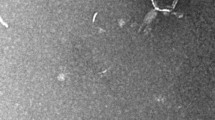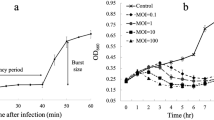Abstract
As an opportunist pathogen, Vibrio alginolyticus (V. alginolyticus), causes disease in marine animals. Bacterial contamination of seafood is not uncommon, and phage therapy is considered a safe way to decontaminate such foods to control the emergence of vibriosis. Here, we report on the isolation of a new, virulent phage called vB_ValP_IME271 (designated phage IME271), which infects V. alginolyticus and was isolated from seawater. Phage IME271 displayed good pH (7–9) and temperature tolerance (< 40 °C) and had a broad host range against Vibrio isolates, including 7 strains of V. alginolyticus and11 strains of V. parahaemolyticus. The IME271 genome was sequenced and annotated, the results of which showed that this phage is a Podoviridae family member with a genome length of 50,345 base pairs. The complete genome is double-stranded DNA with a G+C content of 41.4%. Encoded within the genome are 67 putative proteins, of which only 22 coding sequences have known functions, and no tRNAs are present. The BLASTn results for IME271 showed that it only shares similarity with the Vibrio phage VPp1 (sequence identity score of 96% over 87% of the genome) whose host is V. parahaemolyticus. Comparative analysis showed that IME271 and VPp1 share a similar genomic structure, and the structural proteins are highly similar (> 95% similarity score). In summary, our work identified a new lytic Podoviridae bacteriophage, which is infective to V. alginolyticus and V. parahaemolyticus. This bacteriophage could potentially be used to control V. alginolyticus and V. parahaemolyticus infections in marine animals.




Similar content being viewed by others
References
Hartley JW, West E, Gothard WP, Hanan HW (1991) Vibrio alginolyticus in the UK. J Infect 23:223
Balebona MC, Andreu MJ, Bordas MA, Zorrilla I, Moriñigo MA, Borrego JJ (1998) Pathogenicity of Vibrio alginolyticus for cultured gilt-head sea bream (Sparus aurata L.). Appl Environ Microbiol 64:4269–4275
Cai X (2005) Pathogenicity and drug resistance analysis of V. Parahaemolyticus. J Lab Med Clin
Liu PC, Lin JY, Chuang WH, Lee KK (2004) Isolation and characterization of pathogenic Vibrio harveyi (V. carchariae) from the farmed marine cobia fish Rachycentron canadum L. with gastroenteritis syndrome. World J Microbiol Biotechnol 20:495–499
Zaidenstein R, Sadik C, Lerner L, Valinsky L, Kopelowitz J, Yishai R, Agmon V, Parsons M, Bopp C, Weinberger M (2008) Clinical characteristics and molecular subtyping of Vibrio vulnificus illnesses, Israel. Emerg Infect Dis 14:1875–1882
Ramamurthy T, Chowdhury G, Pazhani GP, Shinoda S (2014) Vibrio fluvialis: an emerging human pathogen. Front Microbiol 5:91
Hörmansdorfer S, Wentges H, Neugebaurbüchler K, Bauer J (2000) Isolation of Vibrio alginolyticus from seawater aquaria. Int J Hyg Environ Health 203:169–175
Hernández-Robles MF, Álvarez-Contreras AK, Juárez-García P, Natividad-Bonifacio I, Curiel-Quesada E, Vázquez-Salinas C, Quiñones-Ramírez EI (2016) Virulence factors and antimicrobial resistance in environmental strains of Vibrio alginolyticus. Int Microbiol 19:191
Lima-Mendez G, Toussaint A, Leplae R (2007) Analysis of the phage sequence space: the benefit of structured information. Virology 365:241
Kutter E (2009) Phage host range and efficiency of plating. Methods Mol Biol 501:141–149
Ellis EL, Max D (1939) The growth of bacteriophage. J Gen Physiol 22:365–384
Stalin N, Srinivasan P (2016) Characterization of Vibrio parahaemolyticus and its specific phage from shrimp pond in Palk Strait, South East coast of India. Biologicals 44:526–533
Stephenson FH (2010) Chap. 4—working with bacteriophages. Elsevier Inc., Amsterdam
Brabban AD, Hite E, Callaway TR (2005) Evolution of foodborne pathogens via temperate bacteriophage-mediated gene transfer. Foodborne Pathog Dis 2:287–303
Lu S, Le S, Tan Y, Zhu J, Li M, Rao X, Zou L, Li S, Wang J, Jin X (2013) Genomic and proteomic analyses of the terminally redundant genome of the Pseudomonas aeruginosa phage PaP1: establishment of genus PaP1-like phages. PLoS ONE 8:e62933
Wilcox SA, Toder R, Foster JW (1996) Rapid isolation of recombinant lambda phage DNA for use in fluorescence in situ hybridization. Chromosome Res 4:397
Werner T (2010) Next generation sequencing in functional genomics. Brief Bioinform 11:499
Kot W, Hansen LH, Neve H, Hammer K, Jacobsen S, Pedersen PD, Sørensen SJ, Heller KJ, Vogensen FK (2014) Sequence and comparative analysis of leuconostoc dairy bacteriophages. International J Food Microbiol 176:29–37
Aziz RK, Daniela B, Best AA, Matthew DJ, Terrence D, Edwards RA, Kevin F, Svetlana G, Glass EM, Michael K (2008) The RAST server: rapid annotations using subsystems technology. BMC Genom 9:75
Tamura K, Stecher G, Peterson D, Filipski A, Kumar S (2013) MEGA6: molecular evolutionary genetics analysis version 6.0. Mol Biol Evol 30:2725
Sullivan MJ, Petty NK, Beatson SA (2011) Easyfig: a genome comparison visualizer. Bioinformatics 27:1009–1010
Birge EA (1994) Bacterial and bacteriophage genetics. Springer, New York
Olia AS, Prevelige PE Jr, Johnson JE, Cingolani G (2011) Three-dimensional structure of a viral genome-delivery portal vertex. Nat Struct Mol Biol 18:597
Sun S, Gao S, Kondabagil K, Xiang Y, Rossmann MG, Rao VB (2012) Structure and function of the small terminase component of the DNA packaging machine in T4-like bacteriophages. Proc Natl Acad Sci USA 109:817–822
Abrescia NG, Bamford DH, Grimes JM, Stuart DI (2012) Structure unifies the viral universe. Ann Rev Biochem 81:795–822
Nasir A, Caetano-Anollés G (2015) A phylogenomic data-driven exploration of viral origins and evolution. Sci Adv 1:e1500527
Li M, Jin Y, Lin H, Wang J, Jiang X (2018) Complete genome of a novel lytic Vibrio parahaemolyticus Phage VPp1 and characterization of its endolysin for antibacterial activities. J Food Protect 81:1117–1125
Yele AB, Thawal ND, Sahu PK, Chopade BA (2012) Novel lytic bacteriophage AB7-IBB1 of Acinetobacter baumannii: isolation, characterization and its effect on biofilm. Arch Virol 157:1441–1450
Biswas B, Adhya S, Washart P, Paul B, Trostel AN, Powell B, Carlton R, Merril CR (2002) Bacteriophage therapy rescues mice bacteremic from a clinical isolate of vancomycin-resistant Enterococcus faecium. Infect Immun 70:204–210
Chadha P, Katare OP, Chhibber S (2016) In vivo efficacy of single phage versus phage cocktail in resolving burn wound infection in BALB/c mice. Microbial Pathog 99:68–77
SPS AV-R, Campbell SA, Inglis NF, Scortti M, Foley S, Vázquez-Boland JA (2013) Genome and proteome analysis of phage E3 infecting the soil-borne actinomycete Rhodococcus equi. Environ Microbiol Rep 5:170–178
Acknowledgements
We thank Sandra Cheesman, PhD, from Liwen Bianji, Edanz Group China (http://www.liwenbianji.cn/ac), for editing the English text of a draft of this manuscript. All authors read and approved the final manuscript.
Funding
This research was supported by a grant from The National Key Research and Development Program of China (2015AA020108), the National Natural Science Foundation of China (31400107 and 81621005), and the State Key Laboratory of Pathogen and biosecurity (SKLPBS1518 and 14J004).
Author information
Authors and Affiliations
Contributions
LZ and YT conceived and designed the experiments and critically evaluated the manuscript. FL and TM isolated and identified the phage and conducted the biological characterization experiments. ZX was responsible for the data and sequence analyses and wrote the manuscript. KF, SZ, and JL collected the clinical bacteria and carried out the experiments.
Corresponding authors
Ethics declarations
Conflict of interest
The authors declare that they have no conflict of interest.
Ethical approval
This research does not contain any studies with human participants or animals that were performed by any of the authors.
Additional information
Edited by Detlev H. Kruger.
Publisher’s Note
Springer Nature remains neutral with regard to jurisdictional claims in published maps and institutional affiliations.
Electronic supplementary material
Below is the link to the electronic supplementary material.
Rights and permissions
About this article
Cite this article
Li, F., Xing, S., Fu, K. et al. Genomic and biological characterization of the Vibrio alginolyticus-infecting “Podoviridae” bacteriophage, vB_ValP_IME271. Virus Genes 55, 218–226 (2019). https://doi.org/10.1007/s11262-018-1622-8
Received:
Accepted:
Published:
Issue Date:
DOI: https://doi.org/10.1007/s11262-018-1622-8




